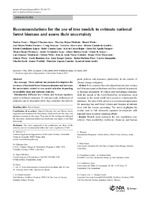Mostrar el registro sencillo del ítem
Recommendations for the use of tree models to estimate national forest biomass and assess their uncertainty
| dc.contributor.author | Matieu, Henry | |
| dc.contributor.author | Cifuentes-Jara, Miguel | |
| dc.contributor.author | Réjou-Méchain, Maxime | |
| dc.contributor.author | Piotto, Daniel | |
| dc.contributor.author | Michel-Fuentes, José María | |
| dc.date.accessioned | 2017-06-01T22:25:02Z | |
| dc.date.available | 2017-06-01T22:25:02Z | |
| dc.date.issued | 2015-09 | |
| dc.identifier | https://www.scopus.com/inward/record.url?eid=2-s2.0-84938651729&partnerID=40&md5=c79cba1aee5b177249925d245f6f041e | es |
| dc.identifier | https://link.springer.com/article/10.1007/s13595-015-0465-x | es |
| dc.identifier.issn | 12864560 | |
| dc.identifier.uri | https://hdl.handle.net/2238/7142 | |
| dc.description.abstract | Three options are proposed to improve the accuracy of national forest biomass estimates and decrease the uncertainty related to tree model selection depending on available data and national contexts. Introduction: Different tree volume and biomass equations result in different estimates. At national scale, differences of estimates can be important while they constitute the basis to guide policies and measures, particularly in the context of climate change mitigation. Method: Few countries have developed national tree volume and biomass equation databases and have explored its potential to decrease uncertainty of volume and biomasttags estimates. With the launch of the GlobAllomeTree webplatform, most countries in the world could have access to country-specific databases. The aim of this article is to recommend approaches for assessing tree and forest volume and biomass at national level with the lowest uncertainty. The article highlights the crucial need to link allometric equation development with national forest inventory planning efforts. Results: Models must represent the tree population considered. Data availability; technical, financial, and human capacities; and biophysical context, among other factors, will influence the calculation process. Conclusion: Three options are proposed to improve accuracy of national forest assessment depending on identified contexts. Further improvements could be obtained through improved forest stratification and additional non-destructive field campaigns. © 2015, The Author(s). | es |
| dc.language.iso | eng_US | es |
| dc.publisher | Springer-Verlag France | es |
| dc.rights | Attribution-NonCommercial 3.0 Costa Rica | * |
| dc.rights.uri | https://creativecommons.org/licenses/by-nc/3.0/cr/ | * |
| dc.source | Annals of Forest Science. September 2015, Volume 72, Issue 6, pp 769–777 | es |
| dc.subject | Manejo forestal | es |
| dc.subject | Carbón | es |
| dc.subject | Biomasa | es |
| dc.subject | Manejo de bosques | es |
| dc.subject | Ecosistemas | es |
| dc.subject | Research Subject Categories::FORESTRY, AGRICULTURAL SCIENCES and LANDSCAPE PLANNING::Area technology::Forest engineering | es |
| dc.title | Recommendations for the use of tree models to estimate national forest biomass and assess their uncertainty | es |
| dc.type | info:eu-repo/semantics/article | es |
Ficheros en el ítem
Este ítem aparece en la(s) siguiente(s) colección(ones)
-
Artículos [36]



